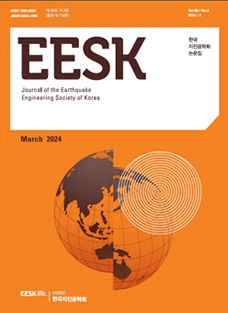1. Introduction
Shear wall is one of the most popular lateral and vertical load-resisting systems being widely adopted in the earthquake-prone regions around the globe. As the modern civilization is relentlessly searching for resilient and safe structural designs that are capable of minimizing disruption, damage, life-threat and economic loss during earthquakes, the shear wall systems have earned the ubiquitous reputation as a viable solution to resist seismic effects by providing high strength and stiffness to the structures [1]. Numerous researchers have investigated to assess the seismic performance of buildings incorporating shear walls. Cando et al. [1] examined the seismic performance of four 20-storied residential buildings with shear walls and performed probabilistic seismic hazard analysis. Islam et al. [10] analyzed three G+10 building models with different earthquake resistant systems and found that shear wall provides the best seismic resilience to the structures. Kassem et al. [11] studied the performance of different retrofitting systems on an existing building at Lebanon and suggested shear wall system as the apropos technique for the seismic retrofitting while Islam et al. [22] and Chakraborty et al. [21] examined irregular structures with shear walls under seismic loadings.
However, shear walls may not be adequate to resist seismic loadings if not properly modeled, leading to disastrous consequences. Ozkul et al. [12] probed two RC buildings at Turkey being damaged during 2011 Van earthquake event and found inadequate design of shear wall to be responsible for this destruction. Furthermore, uneven distribution of seismic energy might also bring in perilous effects to the structure, which increases the extensive utilization of passive energy dissipative systems in important buildings being situated in high seismic risk zones [13]. Researchers around the world have invented numerous dampening systems and their efficacy varies based on different site parameters. Rakesh et al. [14] investigated the performance of different types of dampers on the earthquake resistance of buildings. Tiwari et al. [13] analyzed two RC buildings with and without Fluid viscous dampers (FVDs) to observe the enhancement in the seismic performance and found FVDs to be highly efficacious in reducing story displacements and drifts. Huang et al. [18] also probed the seismic performance of buildings with FVDs and observed its efficiency in mitigating overall drift demands.
Fragility analysis is widely utilized as an indicator for illustrating the possibilities of structural damage under varying levels of seismic tremor as they indicate the conditional probability of exceedance of a specified damage state based on the earthquake intensity-damage relations [15]. In the last decade, numerous scholars have evaluated the seismic performance of different lateral load resisting systems by developing fragility curves. Zhang et al. [16] investigated the effects of adding Tuned Mass Dampers (TMD) to ameliorate the seismic performance by comparing the fragility curves and reported the capability of TMDs to significantly diminish the structural demands. Some researchers have proposed some novel design methodologies to combine several earthquake-resistant systems for the improved seismic performance of buildings. De Domenico & Ricciardi [17] studied an unconventional application of two dampening systems and declared this conjunction as highly advantageous and effective for seismic strengthening of buildings. Reggio & Angelis [19] proposed and investigated the effects of using TMDs in buildings having inter-story isolation system. Lee et al [20] proposed a hybrid damper system consisted of a friction damper (FD) and strip damper for multi-level seismic protection of buildings. The investigation of the safety margin pertinent to the collapse prevention capacity of the structures having dual earthquake resisting systems under seismic events is emphasized in this study. The main objective of this study is to experience the effects of using combined earthquake resistant systems to improve the seismic performance of structures.
2. Adopted methodology
In order to evaluate the structural vulnerability of the developed models, incremental dynamic analysis (IDA) was performed as the tool to obtain the safety margin of the modeled structures. Furthermore, fragility curves are developed as a part of the probabilistic approach as per five performance levels stipulated by Xue et al [2] and presented in Table 1, followed by the computation of collapse margin ratio (CMR) which is introduced as a novel seismic indicator by following the method specified in FEMA P695 [3]. Finally, the seismic vulnerability of the studied systems are investigated by analyzing the results. Fig. 1 illustrates the methodological work flow for different cases.
2.1 Modeling of Building Systems
Over the years, numerous earthquake resistant systems are being invented around the globe. Among scads of seismic prevention systems, RC shear walls are considered to be one of the best options to diminish the structural vibration and response when subjected to earthquake motions. The performance of shear wall system largely depends on the positioning of the shear walls. In addition, the buildingdamper system modeled as per the provisions of a seismic code is proven to be able to resist the effects of strong earthquakes (Wu et al. 2020 [4]). Damper system is quite effective in dissipating energy released by seismic ground motions. In this study, an attempt has been made to observe the combined effect of these two earthquake resisting systems on the seismic behavior of a structure. A G+30 storied building was modeled according to ASCE 7-16 and ACI 318-14 without any lateral force resisting system. This model was upgraded by adding shear walls (SWs) at varying positions (Core, Corner and Side). To exhibit the nonlinear behavior of shear wall (SW), wall hinges (P-M) with a reinforcement ratio of 0.3% were assigned. In the case of beams and columns, plastic hinges were appended to the beam and column faces. The beams had only M3 moment hinges while the columns had axial and biaxial moment hinges (P-M-M). Further, five different types of dampers (Friction dampers (FD), Fluid Viscous dampers (FVD), Friction Pendulum (FPD), Base isolated Lead Rubber Bearing (LRB) dampers, and Tuned Mass dampers (TMD)) are incorporated in each of the building with shear wall system whose properties are presented in Table 2. A total of 19 models were developed and analyzed in this study. Fig. 2 represents the 3D view of all the models while Figs. 3 and 4 illustrate the generalized forcedisplacement curve for linear and nonlinear dampers and the nonlinear moment-curvature relationship curve of columns, respectively. Tables 3 and 4 depicts the overview and parameters used for modeling the buildings.
2.2 Nonlinear Dynamic (Time-History) Analysis
Nonlinear time-history analysis (NL-THA) utilizes the real-time earthquake data to obtain the structural performance of a particular structure when subjected to earthquake ground motions. NL-THA provides the most realistic seismic behavior of structures, which makes it the most preferable dynamic analysis method. Incremental Dynamic Analysis (IDA) is performed to probe the seismic response of the structure under earthquakes with varying intensity levels and is constructed depending on the relationship between drift ratio (IDR) and the intensity of earthquake (PGA) as Nazri [5] stated that peak ground acceleration (PGA) is the most widely used parameter in developing IDA curves. Different seismic code provisions like NEHRP [7] and ASCE [6] have strongly prescribed the utilization of minimum three sets of ground motions in order to assess the seismic performance evaluation. In this study, seven sets of strong earthquake motion data that were chosen from Pacific Earthquake Engineering research Center (PEER) NGA database for each building model were utilized which are presented in Table 5. All the ground motions were spectrally matched to the target response spectrum as demonstrated in Fig. 5.
2.3 Fragility Curve Development
In order to predict the probability of structural damage and analytically fathom the risk of structural hazard due to earthquake events, fragility curves are extensively used. It is also considered an indispensable tool for making retrofitting decisions. To observe the seismic performance of structures, %drift and PGA values from the incremental dynamic analysis (IDA) are used in creating fragility curves even though numerous factors contribute to the critical damage of structures. In this study, five performance levels (OP, IO, DC, LS, and CP) as declared by Xue et al. [2] are utilized. According to Ibrahim & El-Shami [9], the equation for developing fragility curves is as follows:
-
**Φ = Standard normal cumulative distribution function
-
μ = Mean logarithmic peak ground acceleration (PGA)
-
σ = Standard deviation of logarithmic peak ground acceleration (PGA)
-
D = Damage state
2.4 Collapse Margin Ratio (CMR)
Initially introduced in FEMA-P695 [3], Collapse Margin Ratio (CMR) is considered one of the best collapse indicators of the last decade that describes the collapse safety of the structure by incorporating the median spectral acceleration with the spectral acceleration of Maximum Capacity Earthquake (MCE) related to the selected site classifications as shown in Table 6. When the probability of structural damage reaches halfway to the life-threatening collapse limit (Pcollapse = 50%), the median collapse intensity can be obtained. Because of its simplicity, the PGA is used in this study as a measure of earthquake intensity. Fig. 6 illustrates the process of obtaining CMR as presented in FEMA P695 [3].
3. Result and Discussion
3.1 Incremental dynamic analysis (IDA)
In this study, an attempt has been made to understand the seismic performance of structures equipped with both shear wall and damper system. To investigate the structural performance under earthquake motions up to the collapse point, the IDA curves are being developed for all the model structures by plotting the PGA of the scaled earthquake data as the intensity measures and the % interstory drift as the damage measures as represented in Fig. 7. ETABS (v.18) software was utilized to execute the nonlinear time-history analysis (NL-THA) using all the selected ground motion data. PGA, chosen as the intensity measure, was incrementally amplified from 0.1 g to 1.4 g after which the analysis was aborted because of the structure’s dynamic instability. Five performance levels (OP, IO, DC, LS, CP) were utilized for evaluating the structural performances. Two specific cases were also chosen for this study. Ground motions with 0.2 g intensity were selected as the first case (case-1) while strong ground motions having 1.0 g PGA intensity were categorized as case-2.
For Case-1 (ground motions with lower intensity), the bare frame model illustrated a nearly 1.7% interstory drift ratio, which significantly crossed the performance limit of damage control (DC) by 1.5%, revealing the fact that the structure will undergo significant damage when subjected to a strong ground motion with higher PGA. In Model-13 where shear walls are at the corner and base isolated LRBs are provided at the base, the drift value equals 0.49%, less than the specified limit of the operational phase (OP), which means the structure remains in continuous service while incurring trivial damage. The interstory drift ratio of all the other models is also within the range of OP (0.5%) when exposed to the earthquake of 0.2 g PGA.
From the observation of mean results, it becomes evident that the drift value obtained from Model-1 (Bare Frame) will be decreased remarkably if the shear wall and damper systems are incorporated and this percentage fluctuates from 71% to 81% depending on the model.
When the ground motions with higher PGA (Case-2) are considered, the stipulated drift range for the collapse prevention (CP) level is completely surpassed by the drift ratio acquired from Model-1, giving the indication of serious structural and non-structural damage. However, models equipped with shear walls and dampers (Model-5 to Model-19) as well as only shear walls (Model-2 to Model-4) exhibited satisfactory performance even when subjected to high-intensity earthquakes. Model-1 (Bare frame) reaches the CP level at 0.3 g while the shear wall models (Model-2 to Model-4) require at least 0.86 g and the models equipped with both shear wall and damper need a minimum of 0.89 g. Among all the models, Model-13 (LRB+ Corner Shear wall) demonstrates the best performance with a maximum value of 1.21 g to reach the CP level, having a mean difference of 75% with Model-1.
From the rigorous analysis of the obtained results, it can be averred that the combined setup of RC shear wall and damper delivers significant improvement in structural performance during seismic events and the seismic performance of structures having only shear walls as load resisting systems is satisfactory even though it is not the best. Another important finding that can be observed from the analyses is that the structural strengthening is acquired by controlling the drift ratios of the buildings while incrementally increasing the PGA up to 1.0 g.
3.2 Fragility curves
Fragility curves are usually plotted to observe the potential of damage when subjected to various earthquake shakings. This method has been upgraded by numerous researchers and is considered to be an invaluable tool to predict structural vulnerability under seismic events. There are scads of formulas developed by researchers around the globe to evaluate fragility curves. The fragility curves of all the simulated models are illustrated in Fig. 8.
From the results, it is conspicuous that the probability of reaching Immediate Occupancy (IO) is 0% for all models except Model-1 when subjected to ground motions with lower intensity (0.2 g). This trend remains the same also for damage control (DC) point where all the models exhibit 0% probability of exceedance while Model-1 illustrates 63% possibility of reaching DC level.
For Case-2 (ground motions with 1.0 g or higher PGA), all models exceed the IO point and the probability is 100%. When DC level is considered, all structures give the notion of reaching that point 100% apart from Model-13 which shows 90% probability of exceedance for earthquakes having 1.0 g PGA. However, this scenario is quite different for CP performance point. Model-1 depicts the maximum probability of damage same as before, indicating total collapse of the structure. Structures incorporating only shear walls (Model-2 to Model-4) point out very lower probability of damage ranging from 4% to 7% in case of CP performance level whereas the other models equipped with both shear wall and damper systems exhibit even lower probability of damage, representing the efficacy of using dual lateral load resistant system.
To sum up, it can be declared that although the shear wall system enhances the structural performance, the combined utilization of shear wall and damper illustrates remarkable structural resilience against seismic loadings.
3.3 Collapse Margin Ratio (CMR)
Collapse margin ratio (CMR) is utilized as an important indicator for the seismic evaluation of the structures which validates the results acquired from IDA analysis. The collapse fragility curves of the modeled structures are shown in Fig. 9. The values of CMR taken from the collapse fragility curves are presented in Fig. 10.
From the table, it becomes apparent that Model-13 (Shear wall at corner+ base isolated LRB) exhibits best performance as it can withstand a maximum PGA of 1.21 g to reach the halfway of lifethreatening structural damage.
4. Verification of proposed system as per Korean Building Code (KBC2016)
In this study, a novel technique is proposed by utilizing the combination of two of the seismic load resisting systems based on the stipulations of ASCE 7-16 code. However, it is necessary to ensure the feasibility of the proposed system by testing it using different building codes available worldwide as significant differences exist between countries' building construction codes. Here, Korean building code (KBC2016) has been selected for probing the viability of the recommended technique. Table 7 showcases the parameters selected for the conversion of the building code from ASCE to KBC2016.
According to the seismic design provisions of KBC2016, the allowable limit for story drift is 0.010hsx, which is similar to the ASCE 7-16 code. As all the buildings were modeled by scrupulously following ASCE 7-16, the story drifts for all the building models have satiated the criteria mentioned in KBC2016 as exhibited in Fig. 11, indicating that the suggested methodology is plausible even if the buildings are designed as per Korean building code standards.
5. Conclusion
The seismic demand of buildings having both shear wall and damper as lateral load resisting system are investigated in this study. A total of 19 models are developed in commercial building analysis software ETABS (v. 18) as per the code regulations of ACI and ASCE. To assess structural vulnerability, incremental dynamic analysis (IDA) was conducted to develop fragility curves for all the models. Collapse margin ratios (CMR) are developed from the IDA curves. From the analysis of the study discussed above, several conclusions can be drawn as follows:
-
∙ Based on the IDA results, it is obvious that inclusion of shear wall system gives good lateral load resisting capacity to the building. However, the combined performance of shear wall and damper provides much better performance under earthquake events as this system can control the seismic responses by dissipating energy much efficiently.
-
∙ Addition of shear wall and damper system significantly increases the seismic performance of structures, enabling them to endure even strong ground motions greater than 1.0 g without illustrating any life-risking damage notions.
-
∙ Among the buildings incorporating only shear wall systems, Model- 3 (shear wall placed at the corners) exhibits the best performance when subjected to earthquakes. Due to the lack of any earthquake resistant systems, Model-1 (Bare frame) depicts the maximum probability of collapse under seismic events.
-
∙ Based on the analysis results, Combination of corner shear wall and base isolated LRB system (Model-13) exhibits the best seismic performance and shows great potential to be espoused practically for increasing the seismic capability of tall buildings.






























